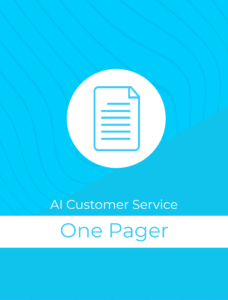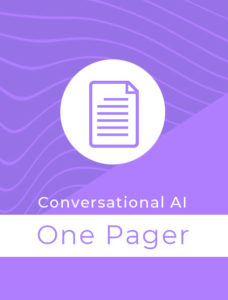Conversational AI: Improve Agent Productivity Like Never Before

With an increasing demand for AI-powered support services, omnichannel deployment, and reducing digital assistant development costs, Conversational Artificial Intelligence (AI) interfaces, like we offer at Aisera, provide deep learning, intuitive, multilingual natural language engagement with unsupervised NLP, NLU, and NLG, in real-time.
In this article, we’ll walk you through how Aisera’s Conversational AI works, and why so many businesses are starting to adopt it. Whether you’re interested in a conversational growth strategy or focused on conversational customer support, we’ll break things down to set you up for success.
The Rise of Conversational AI Assistants
Closing the Communication Gap Language is the ultimate human communication tool. Initially, AI communication took the form of the now-familiar supervised digital assistants. But primitive virtual assistants had a number of limitations which often frustrated users. They lacked the versatility and agility of a true Conversational AI Assistant – one that could derive meaningful context, support business applications, and improve the all-important user experience.
How did Conversational AI Assistants grow to eclipse the basic digital assistant? The answer is that they were limited from the start by their fundamental NLP/NLU architecture, which is supervised (as opposed to unsupervised). That difference became the key factor in digital transformation and future-proofing AI applications.
Where to start Conversation with AI?
Agent copilots are quickly replacing live chat agents. Conversational AI applications can answer frequently asked questions and even offer personalized advice, often with a higher response quality and a lower response time than would be possible or expected with human conversations.
Conversational AI often has a meaningful positive impact on both the bottom line of your customer experience and service function as well as your net promoter score (NPS).
Conversational Assistants also eliminate long customer wait times for responses and resolutions. By understanding what the customer is asking for, Conversational AI solutions provide immediate answers to support requests, making self-serving more streamlined and appealing to customers.
As more and more customers serve themselves, service agents can focus less on solving repetitive queries and more on handling high-priority issues.
For faster adoption of Conversation with AI, the best place to start is introducing the conversational assistant on the website and mobile apps to support customer service and customer intelligence as use cases.
Website Portals and Mobile Apps
Introducing Conversational AI makes onboarding frictionless and intuitive by replacing predefined forms with user-driven messaging. Whenever you ask users to pick from a predefined list, there is a chance that your options are confusing or limited. By instead allowing customers to ask questions and write answers in their own words, orgs can avoid confusion and improve the customer support experience.
Conversational AI tools also enable brands to take a more proactive approach vs. being reactive, i.e. rather than hoping users will navigate to a specific page on their website or mobile app to express interest in your product, AI-powered digital assistants allow them to do so from any page on your website.
Finally, Conversational AI is helping to route customer support tickets more effectively. One way this happens is by combining customer intelligence data with user-driven inputs to help direct support requests toward the appropriate human agent. Further, conversational interfaces allow for a great deal of “branching logic” without costly tech investment, allowing you to distribute requests in a more accurate manner.
Collaboration Platforms such as MS Teams/Slack/Zoom
A Conversational Assistant can leverage existing resources to automate and enable self-service to take over and handle many of the mundane tasks and cases of support agents. Conversational AI helps deliver top-of-the-line self-service resolutions and 24×7 support for employees.
A perfect example of this can be seen in how Dartmouth was able to autonomously resolve common IT questions, enable increased self-service, and provide proactive user engagement on Slack and webchat by implementing Aisera’s Conversational AI Solution. Dartmouth realized an 86 percent improvement in the auto-resolution of support requests and saved over $1 million in annual service desk costs.
How Can Conversational AI Help Enterprises?
Aisera’s Conversational AI Assistants address the entire spectrum of Artificial Intelligence Service Management (AISM) – employing Conversational AI to resolve Customer Service issues, plus modernizing and speeding workflow automation for the service desk. By creating extra time for human agents to problem-solve the most-complex inquiries, customers end up with a far better experience at every step of their journey.
These advances translate into auto-resolution of 65 percent of support requests; a 90 percent improvement in resolution times; and an 80 percent boost in customer satisfaction. The proof is coming in daily and picking up momentum. The sophistication and monetization of the AI Conversational Platform have virtually no limitations in sight at this point. Even the Covid pandemic has inadvertently turned out to be an engine of growth for this dynamic technology.
Unsupervised AI frees service desk agents from manual processes such as solving individual IT issues as routine as password resets. Instead, employees can simply speak with a digital assistant and take care of their own issues without even consulting the IT team. The reduction in complexity not only reduces costs but yields astonishing improvements in user satisfaction.
The Power of Unsupervised NLP/NLU
The acronyms that define AI conversational technology have become part of our normal lingo, but it’s worth noting that these simple, three-letter abbreviations represent a revolution in human communication: NLP or Natural Language Processing grew out of classic verbal linguistics and defines the ability of software to manipulate speech and text – a momentous computational leap.
NLU or Natural Language Understanding encompasses syntax, semantics, knowledge about the world and abstract elements of language that we take for granted, even when casually speaking.
NLU further opened the door to NLG or Natural Language Generation. A further advance, Emotion AI, can actually comprehend the nuances and feelings that people infuse into words, which is vital to interpretation and understanding.
Aisera has taken Unsupervised Natural Language Understanding into a whole new arena with its out-of-the-box Conversational AI Platform, whose unsupervised Conversational Assistants can effortlessly reach across the omnichannel to resolve user requests. This platform is easily tailored to industry verticals, dispensing knowledge that enables comprehensive self-service and automates manual service desk tasks at an unprecedented scale.
Dynamic Workflows, And How it’s a Game Changer
AI Workflow Automation simplifies and improves existing business processes that are often manual and human-dependent. What does that mean? For one, it allows for the encoding of more processes into systems with AI and automation, which can then be efficiently performed autonomously. Only recently, as more processes become encoded into these systems, the automating of workflows was becoming a staple for enterprises embarking on their digital transformation journeys. With the ruthless onset of the COVID-19 pandemic, AI Workflow Automation flashed from a popular trend to a dire emergency. Survival itself became an issue for many businesses, and that meant moving faster to optimize workflows than had ever been imagined as the staggering consequences of the pandemic began to impact the economy.
Most or all digital assistants today require you to build and develop workflows and then they may look at adding branching instructions using the NLP/NLU interface, but this is not a scalable approach. These are manual workflows, which get created as guided decision trees with users for knowledge bases, FAQs and historical content creation.
Aisera’s dynamic workflows are derived by leveraging unsupervised NLP, NLU, and NLG in an automated manner for knowledge bases and historical content; but users are not involved in creating any workflows.
Conversational AI learns from every touchpoint and automates repetitive inquiries and workflows using NLP & NLU. Helping customers help themselves also empowers agents, who can now focus on issues that require a human touch. By augmenting human intelligence, an AI Conversational Assistant helps your organization nurture and satisfy customers who then purchase more, remain loyal, and tell the world how they value you. You can book a free conversational AI demo now!



